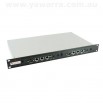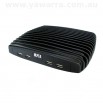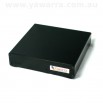Cleaning up an untidy stack of network appliances
by Craig Tosi
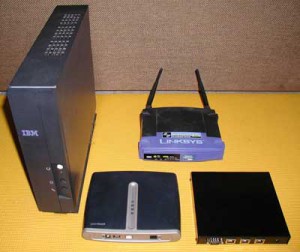
The untidy pile of network devices to be consolidated
One day about 6 months ago I was sitting in my home office looking at an untidy stack of devices.
They included an old DSL Modem, WRAP pfSense® Router, a Wireless Access Point (DD-WRT’d WRT54G), and an old IBM Netvista thin client running AstLinux (Asterisk IP PBX) with a TDM400P analogue telephony card.
While I was quite happy with the function of each of the devices, I was a bit irritated by the haphazard stack of boxes and associated cable spaghetti.
Then I looked at the final vacant 1RU in my little 4RU wall frame. I started to wonder whether I could cram all that functionality into that space. So the mission became a 1RU box containing:
- pfSense® Router and Wireless Access Point
- Askozia IP PBX with Analogue Telephony Card (Askozia is derived from monowall and targeted at embedded hardware)
- DSL 2/2+ Modem
I toddled off to Jaycar and bought myself a basic modular 1RU rackmount box for around $70. I’d already settled on using the board out of a Linksys AM300 DSL modem as they have a nice small form factor.
I already had a spare net4801 board lying around and for a long time considered it the basis for the Asterisk PBX along with my existing telephony card.
I soon realised though, the width of the paired net4801 and telephony card wasn’t going to leave enough room for the other devices. I figured the net4801 could be used for the router/access point board.
I purchased a Senao 600 mW mini-PCI card, pigtails and antennas from Yawarra to take care of the Wireless Access Point requirement and a 2.5″ HDD bracket to add some storage.
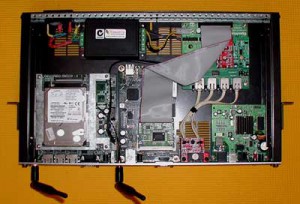
An internal view of the reconfigured devices
Given that the PBX only needed 1 ethernet port I started to search for a narrow single ethernet embedded board that had a PCI slot. Well, something like that may exist but I wasn’t finding it.
Then I started to think about the ALIX 3 board. Its narrow form factor was perfect, and it has 2 mini-PCI slots. Enter the OpenVox A400M mini-PCI analogue telephony card. It just happens to be completely compatible with the Digium FXS and FXO modules that were already installed in my existing telephony card.
The densely packed front panel of the new 1RU case
You’ll see in the photo that the A400M utilises a standard IDE hard drive cable to interface with the mini-PCI board. That gave me the added flexibility to mount the telephony card in the rear of the chassis.
It was just a matter of chopping up a few old PCI modems and stacking the dual RJ-12 outlets to provide the 4 required telephone cable ports in the front panel. For those of you who may have a digital telephony application in mind, mini-PCI ISDN BRI cards are also available.
With all the boards decided on, the only issue remaining was how to power them. Yawarra were happy to provide the same internal PSU that goes into their rackmount boxes.
My original intention was to employ 2 of these to power all the boards. As it turned out I could only cram one in. It powers both the net4801 and the telephony card.
Powering the ALIX3 and DSL Modem would have required soldering (read ‘voiding of warranty’) so I’ve settled for conventional AC Adaptors via front panel plugs at this stage. Maybe in future a higher rated internal PSU could power the entire box.
The only other future enhancement I’m looking at is including some neat little fibre-optic LED extenders to bring indicator lights for each of the boards to the front panel.
Thanks to Paul McGowan at Yawarra for help, advice and a willingness to accommodate all my unusual requirements.
– Craig Tosi
Mobile: 0417 466 310
Email: craig@tosi.id.au
Want more great articles like this?
Sign up for email updates and get them delivered straight to your inbox.
We'll also donate $5 to Voyage Linux, to support the ongoing development of this fantastic software.
Sign me up!


